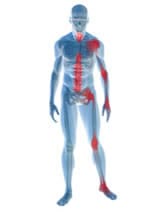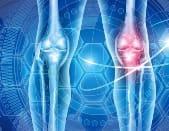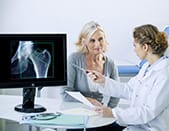
Osteoarthritis primarily affects the weight-bearing joints, that is to say, those of the hip, knee and spine.
Some non weight-bearing joints, such as those of the fingers and thumb, can also be affected.
It is rare for other joints to have lesions due to osteoarthritis, except as a result of trauma (sprain, fracture, etc.) or any unusual stress (repeated sports movements, etc.).
Osteoarthritist of the knee (Gonarthrosis)
This is the most common location of osteoarthritis. It most often affects women after the age of 40. The symptoms of osteoarthritis of the knee are as follows:
Osteoarthritis pain
Osteoarthritis pain covers every level of intensity from very moderate to unbearable. It is generally located in the affected area, on the inside or outside of the knee, but sometimes it also seems to have no precise connection with the affected area, in particular, when it is located in the shallow depression located at the back of the knee-joint (known as the popliteal fossa). Osteoarthritis pain is essentially linked to activity, walking and going up and down stairs. It is accentuated by excess weight and carrying heavy loads. It generally diminishes with rest and when sitting or lying down. It is sometimes accompanied by inflammation and while at rest, may wake the patient up during the night.
Swelling or synovial effusion
The synovial membrane of the knee, irritated by the cartilage and the many inflammatory products released during osteoarthritis increases the production of the intra articular lubricant known as synovial fluid.
It is can sometimes be produced in a very large quantity and lead to severe pain due to the hyperpressure it is responsible for, in particular in the back of the knee. When there is significant synovial effusion joint aspiration may be necessary.
Osteoarthritis of the hip
This is the second most common location of osteoarthritis. Without a congenital skeletal abnormality osteoarthritis of the hip generally sets in at around 60 years of age and is facilitated by excess weight and hard labour. A hereditary factor may also be found in some families.
Secondary osteoarthritis appears at around 45 years of age and is due to acquired or congenital malformations of the hip. These malformations must be detected early on by x-ray because they may require corrective surgery (with a preventive aim).
Osteoarthritis of the hip pain settles in the fold of the groin or buttock and may irradiate down to the front of the thigh and descend right down to the knee. Sometimes the pain is only felt in the knee.
Osteoarthritis of the hand
This location is predominant in women during the menopause. br>The risk factors are genetic, hormonal and micro-traumatic.
It is necessary to make a distinction between osteoarthritis of the fingers and osteoarthritis of the thumb.
Osteoarthritis of the fingers
It generally affects the last joint in the finger and develops slowly. In general, the symptoms consist in either an unattractive deformation or a painful flare-up. The main sign is the appearance of nodes (swellings) on the joint nearest the fingertip, appearing at first on the index and middle fingers, then moving sideways and extending to the other fingers.
Osteoarthritis of the thumb
The pain settles in the base of the thumb. It is provoked by pinching or tightening motions. It may be limited to a simple pain for firm movements, but can also lead to painful stiffening of the joint. As it evolves, the lesions may end in deformation of the first phalange of the thumb (the trapezo-metacarpal joint shifts, the two bones of the joint are no longer in correct alignment with one another).
Osteoarthritis of the spinal column
X-rays showing osteoarthritis of the spinal column are frequent, but very often there are no symptoms. It affects three regions of the spinal column:
Cervical osteoarthritis
It is almost constant on x-rays after 40 years of age. It sometimes manifests itself by stiffness of the neck and painful spots accompanied by cervicalgia (neck pain) which may become chronic (continuous pain for more than 3 months) accompanied by acute bouts of pain following trigger factors.
Dorsal osteoarthritis
It manifests itself by pain in the middle region of the back. It can also lead to pain in the chest. Hence the symptoms may be difficult to pin down (the patient sits on one buttock), pain on breathing or on touching the back.
Lumbar osteoarthritis
This is the most frequent spinal location. Pain is present every day, but becomes more intense during activities or prolonged static positions. Its evolution may lead to long term pain on walking, accompanied by pains which disappear shortly after stopping.
Osteoarthritis of other joints
Shoulder
Osteoarthritis of the shoulder is often due to a traumatism (fracture, etc) or local pathology.
Elbows
This osteoarthritis is quite rare. It is caused by small repeated traumatisms, notably related to work.
Ankles
This is caused by a traumatism (serious sprain or fracture).



















